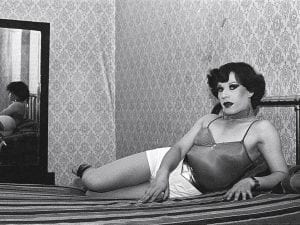Galleria Raffaella Cortese presents three solo shows in Milan, settled into different spaces. Through their works, the artists show both parallels and dissimilarities. The main gallery space hosts a second solo show by Swiss artist Silvia Bächli (1956, Baden). The exhibited works, made between 2013 and 2015, show the latest developments of her aesthetic approaches, in terms of sign, colour and gesture.
Not so far away from the headquarter – less than a one-minute walk – sit the exhibitons at Raffaella Cortese which never cease to amaze. Beyond a large, ancient window, another solo show focuses on works by Ana Mendieta (1948, Havana – 1985) created in Rome: in particular ink, watercolour and pencil drawings, some of which were studies for sculptures. This is the second solo exhibition of Cuban-born artist at the gallery. Its project room features the book of lithographs Duetto Pietre Foglie, made during her Roman residency, and a precious notebook from 1981, with some preparatory studies. The ineluctable qualities her works share are evident in the physical and temporal aspects of this joint outdoor piece. Minimalist pencil drawings assert a relation to the viewer’s body that traditional sculpture does not. Critical assessment of Mendieta’s last phase of work from the 1980s has been clouded by the circumstances surrounding her violent death at age thirty-six.
In March 1983, the artist received the Prix de Rome, giving her a residency at the American Academy, along with the opportunity to work indoors with new materials in her first actual studio space. There she ceased to create works in the landscape and turned to making art objects in studio, such as sculptures and drawings, which still incorporated the Siluetas shapes of her earlier works. Photographs of the Silueta series, her first solo show in New York, were affixed to the walls, in 1979.
While recognised for her early performance-based work and earth-body series Siluetas, the object-making Mendieta began in the final years of her life has been rendered in the same mystery as her relationship with Carl Andre. When she died in a fall from the thirty-fourth floor of a Greenwich Village apartment building, she was married to him. He was the only other person in the apartment on the morning of September 8, I985,when she fell.
Yet an examination of their creative synergy offers insight into Mendieta’s intent as she searched for ways to bring her earth art into the gallery as permanent sculpture. Despite its deplorable end, their five-year partnership resulted in joint exhibitions, travels, shared friendships, political affinity, and artistic collaboration on a book of lithographs.
In the same street, but in another building, Raffaella Cortese shows the first solo show in Italy by Iranian artist Nazgol Ansarinia (1979, Tehran.)The exhibition revolves around three ongoing projects by the artist that well represent her practice and recent developments. Central to her production are the collages from the Reflections/Refractions series. On the walls Ansarinia built an archive of notes, drawings, recordings and photographs about her daily experiences. Upon her return to her homeland, she saw them in a new light and became interested in their use of symbols and geometry. Newspaper collages on metal sheet supports become immersion fields of light and reflection, symmetry and abstraction, communicating that sublime, unknowable, invisible force of the meditation traditions.
For her latest project, Membrane, Ansarinia shows the monumental impression of a wall, mapped by the artist through a 3D scanner, recreating it as a three-dimensional model, which keeps a trace of the destroyed building. In the centre of the space, a new sculpture from the Pillars series casts a satirical eye on the rise of Tehran’s emerging middle class. New houses built across the city with neo-classical columns are the latest display of wealth. “I find them ugly and ostentatious. They have nothing to do with us,” she says in a recent interview. “Today in Tehran, you have a lot of expensive cars, luxury brands and large shopping malls. I grew up during the Iran-Iraq war; consumerism was scarce back then.”
Ginevra Bria
Credits:
1. Nazgol Ansarinia, Paper trail (2016) installation view at Galleria Raffaella Cortese, Milano. Photo: Lorenzo Palmieri
2. Ana Mendieta (2016) installation view at Galleria Raffaella Cortese, Milano. Photo: Lorenzo Palmieri




